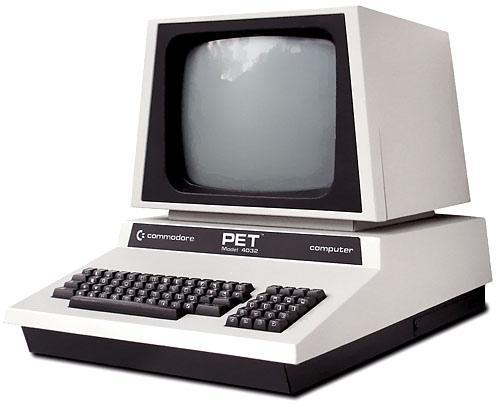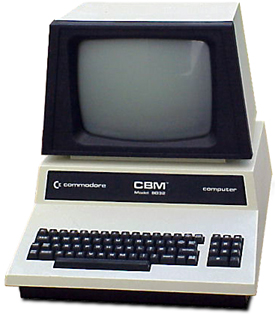|
|---|
History of Commodore Computers |
- 1953: Jack Tramiel opens a typewriter repair shop in the Bronx, New York.
- 1954: Tramiel founds Commodore.
- 1955: Tramiel relocates to Toronto and becames the biggest manufacturer of low cost office furniture in Canada
- 197? Commodore manufactures calculators and digital watches, but gets killed by Texas Instruments.
- 1976: Commodore purchases MOS Technologies, an American maker of IC chips. MOS' senior engineer, Chuck Peddle
was working on the 6502 micro processor. A popular 8 bit processor that soon would be used in machines like
the Apple II, the Atari 800, the Commodore PET and 64.
- 1977: January - Commodore first shows a prototype PET computer at the Winter Consumer Electronics Show.
- 1977: January - Commodore's Chuck Peddle shows the first PET to Radio Shack, hoping to have Radio Shack sell it.
- 1977: April - Commodore Business Machines Inc. shows its PET 2001 computer for US$600. The computer shown is a one-of prototype.
- 1977: June - Commodore shows its first production PET computers at the Summer Consumer Electronics Show.
- 1980: May - Commodore Business Machines introduces the CBM 8032
microcomputer, with 32KB RAM and an 80-column monochrome display.
- 1980: May - Commodore Business Machines introduces the CBM 8050 dual 5 1/4-inch floppy disk drive unit.
- 1980: Commodore Japan introduces the VIC-1001 (later called the VIC-20 in the USA).
- 1981: January - Commodore announces the VIC-20, for US$299. During its life, production peaks at 9,000 units per day.
- 1982: Hi-Toro Incorporated is formed by a group of midwest investors trying to
cash in on the video game craze. The name was later changed to Amiga, Incorporated after
being confused with the lawn-mower manufacturer, Toro. Within one year, there are rumours of an incredible
computer codenamed Lorraine featuring unheard of graphics and sound capabilities, multitasking,
80 column display, 5+ megs of Ram and MORE!
- 1982: January - Commodore announces the Commodore 64 microcomputer, showing a prototype at the Winter CES, for US$600) for US$595.
- 1982: January - Commodore introduces the 16K SuperVIC.
- 1982: April - Commodore announces the B (700) and P (500) series of microcomputers, for US$1700-3000.
- 1982: June - Commodore Business Machines introduces the BX256 16-bit multiprocessor professional microcomputer, for US$3000.
- 1982: June - Commodore Business Machines introduces the B128 microcomputer, for US$1700.
- 1982: June - Commodore Business Machines announces the P128 microcomputer. It is to be an enhanced Commodore 64 with 128KB RAM expandable to 896KB. Price US$995.
- 1982: September - Commodore Business Machines begins shipping the Commodore 64. Suggested retail price is US$595.
- 1982: Commodore releases the 1540 Single-Drive Floppy for the VIC-20.
- 1983: January - Commodore Business Machines begins selling the Commodore 64 through mass merchants, which drops the retail price to US$400.
- 1983: January - At the Winter CES, Commodore debuts the Commodore SX-100, a portable version of the Commodore 64, with bundled B/W screen, for US$995. Price with color screen and two drives is US$1295.
- 1983: January - At the Winter CES, Commodore demonstrates the HHC-4 (Hand-Held Computer). It features 24-character LCD screen with 4 KB RAM expandable to 16 KB. This was one of Commodore's pre-PET business products. Price is US$199.
- 1983: January - Commodore's sales of VIC-20s reaches 1,000,000.
- 1983: January - Commodore introduces the SX-64, the first color portable computer. Weight is 10.5 kg. It incorporates a 5-inch color monitor and one or two 5.25 inch floppy drive. Price is US$1600.
- 1983: April - Commodore drops dealer prices on the VIC-20, which allows it to drop below US$100 retail, the first color computer to hit that mark.
- 1983: April - Commodore offers a US$100 rebate on the purchase of a Commodore 64 on receipt of any computer or videogame unit.
- 1983: May - Commodore ships the Commodore Executive 64. It features 64KB RAM, detachable keyboard, 5-inch color monitor, 170KB floppy drive, for US$1000.
- 1983: June - Commodore drops the dealer price of the Commodore 64 to US$200, allowing the retail price to drop to US$200-230.
- 1983: June - At the Summer CES, Commodore shows the B128/256-80, formerly called P128. It has a monochrome monitor with 80-column display.
They also show the Executive 64, formerly the Commodore SX-100. It has a 6-inch color monitor and is priced at US$995.
- 1983: Commodore debuts the Exactron Stringy Floppy, a high-speed cassette-based data storage device.
- 1984: January - Jack Tramiel,President of Commodore International, has a disagreement with the major share holder, Irvin Gould.
Tramiel leaves the company and a few months later buys Atari.
- 1984: January - At the Winter CES, Commodore shows the SX-64, formerly called Executive 64. It now includes a 5-inch monitor, and one 170KB 5 1/4 disk drive, for US$995.
- 1984: January - Commodore announces that during 1983, Commodore sold US$1 billion worth of computers, the first personal computer company to do so.
- 1984: June - Commodore announces the Commodore 16. Former name was TED-16 and is expected to sell for around US$100, and marketed as "The Learning Machine".
- 1984: June - Commodore announces the Commodore Plus/4, formerly called the Commodore 264. It will now feature four built-in programs, not just one. Price should be around US$300.
- 1984: August - Commodore purchases Amiga Corporation.
- 1984: Commodore stops manufacturing the VIC-20.
- 1985: January - Commodore unveils the Commodore 128 Personal Computer. It functions as three computers in one: a complete Commodore 64, a CP/M mode, and a new 128KB mode.
- 1985: January - Commodore announces the 1571 Disk Drive, for the Commodore 128.
- 1985: July - Commodore unveils the new Amiga 1000 in New York, for US$1300.
- 1985: Commodore stops production of the Commodore 64 several times during the year, restarting each time based on public demand.
- 1986: Commodore releases Transformer software for the Amiga, which, along with the Commodore 1020 5 1/4-inch disk drive, provides limited MS-DOS compatibility.
- 1987: January - Commodore announces the Amiga 500 and the Amiga 2000.
- 1987: January - Commodore debuts the Commodore 128D in the North American market.
- 1988: December - Commodore announces the A2286D Bridgeboard for the Amiga 2000. The A2286D contains an 8-MHz Intel 80286 and a 1.2MB 5 1/4-inch disk drive.
- 1988: Commodore introduces the Amiga 2000HD and the Amiga 2500.
- 1989: January - Commodore announces that 1 million Amiga computers have been sold.
- 1989: November - Commodore announces the Amiga 2500/30. It is essentially an Amiga 2000 with a 2630 Accelerator Board (25-MHz 68030 and 68882 math coprocessor).
- 1990: April - Commodore offers Amiga 1000 owners US$1000 to trade in their Amiga on a new Amiga 2000.
- 1990: June - Commodore ships the Amiga A3000 computer.
- 1990: September - NewTek ships the Video Toaster, a hardware/software video effects tool for the Commodore Amiga 2000, for US$1600.
- 1990: Commodore announces the Amiga 3000. Prices start at US$4100 with a monitor.
- 1991: January - Commodore releases the CDTV package. It features a CD-ROM player integrated with a 7.16-MHz 68000-based Amiga 500. List price is US$1000.
- 1992: Commodore introduces the Amiga 600 for a base price of $500.
- 1992: September - Commodore introduces the Amiga 4000.
- 1992: December - Commodore introduces the Amiga 1200.
- 1994: Commodore International and Commodore Electronics (two of the many international components of Commodore Business Machines) file for voluntary liquidation.
- 1995: April - At an auction in New York, ESCOM buys all rights, properties, and technologies of Commodore.
- 1997: Gateway buys bankrupt Amiga.
Source:
Chronology of Events in the History of Microcomputers
| |
|---|
|
 4032 refers to 40 character display, with 32K RAM memory.
4032 refers to 40 character display, with 32K RAM memory.
 Commodore also released the CBM 8032 at about the same time as the PET 4032. It is similar,
but displays 80 characters per line of text, a vast improvement over the 40 characters of previous PETs.
Commodore also released the CBM 8032 at about the same time as the PET 4032. It is similar,
but displays 80 characters per line of text, a vast improvement over the 40 characters of previous PETs.